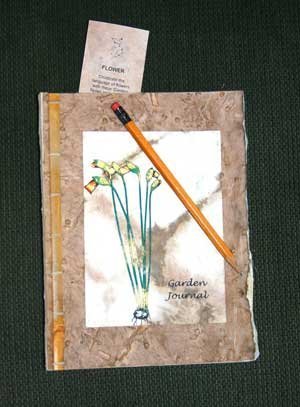
If you don't already keep one, fall is a great time to consider starting a garden journal. Now that things are winding down for most gardeners, you may be able to find a little more time to organize your thoughts and reflect on the successes and disappointments of the past season. A garden journal doesn't need to be complicated, but you'll find that keeping a few records from year to year can be rewarding as well as saving you a lot of time and frustration.
There are probably as many types and styles of garden journals to choose from as there are gardeners . I think the most important aspect to remember when selecting or creating your journal is practicality. I'm not suggesting that style isn't important. It's wonderful if you find a journal that's aesthetically pleasing to you, but if it's not functional, it isn't really practical. It's my humble opinion that a simple three-ring binder makes the best garden journal. It's cheap and easy to create, and it allows for flexible record-keeping (you can add lined paper, graph paper, pockets, dividers and photo pages). If you're worried about aesthetics, there are binders available with clear pockets on the front and back covers allowing you to personalize it according to your style. Another plus is durability-you can take it with you outside-a big advantage for those of us who seem to forget our thoughts on the walk from the garden to the back door.
If you like the idea of using pre-printed forms for record keeping, most software for the home office (like MS Office or MS Works) comes with some type of feature that will let you create journal pages or spreadsheets from pre-designed templates. There are also several free sources available on the web. Here are two links to get you started:
The first rule of keeping a garden journal is that there are no rules! It can be as easy or as complicated as you want to make it. Besides, if you're like most gardeners, you would probably rather be spending time out in the garden than taking copious notes in a journal. Even so, recording a few key bits of information can save you a whole lot of time and frustration in the long run and help you maximize the enjoyment you get from all of your hard work each year. Because conditions can vary so much even within each growing region, your own records will always be your best source of information.
Photos are a wonderful way to streamline your record keeping, document your observations and tell your garden's story. Set aside some pages in your journal (or in a photo album or on your computer) to keep pictures of your garden's progress.

About The Author: Ellen Brown is an environmental writer and photographer and the owner of Sustainable Media, an environmental media company that specializes in helping businesses and organizations promote eco-friendly products and services. Contact her on the web at http://www.sustainable-media.com
Add your voice! Click below to comment. ThriftyFun is powered by your wisdom!